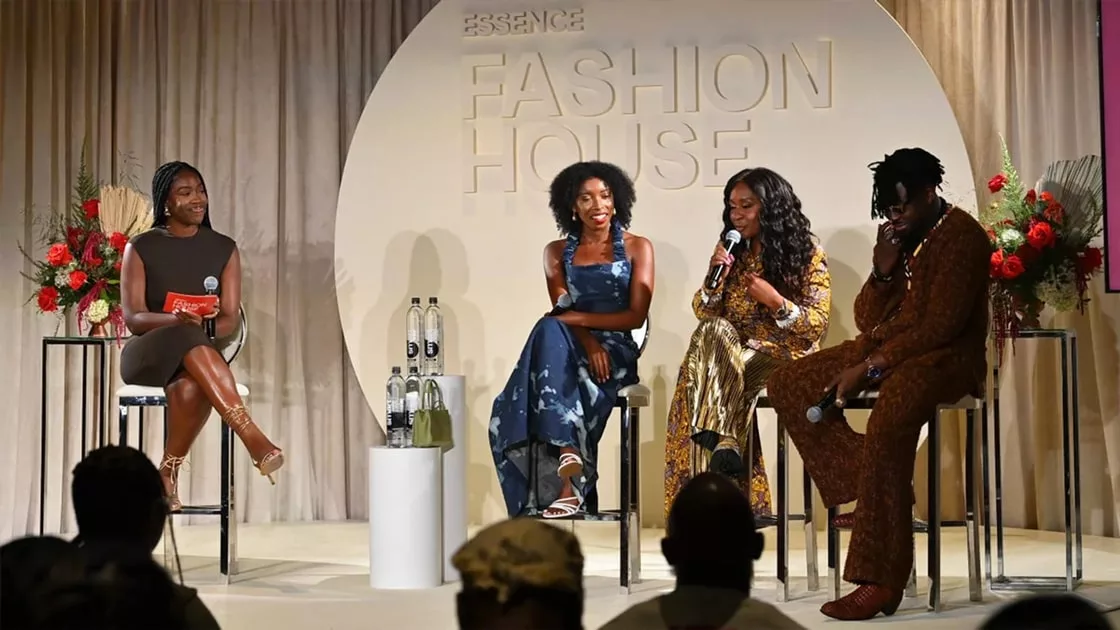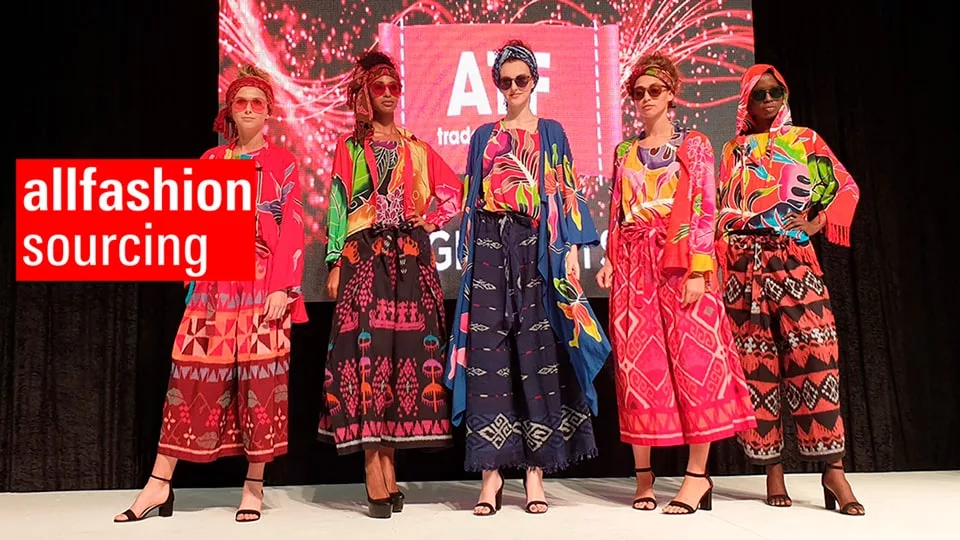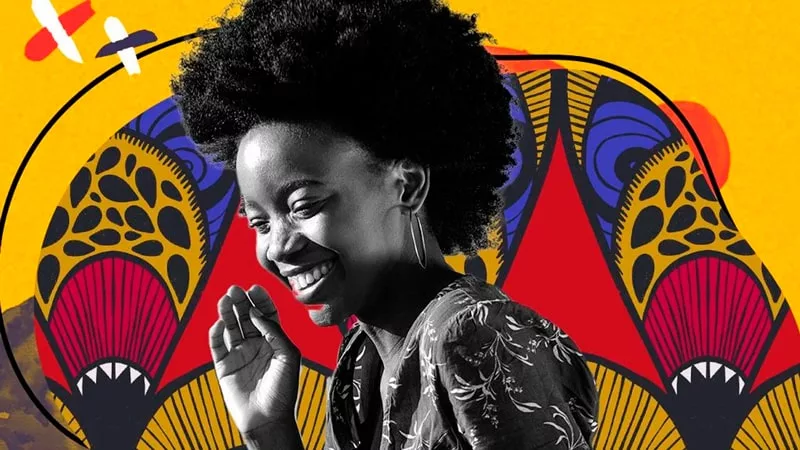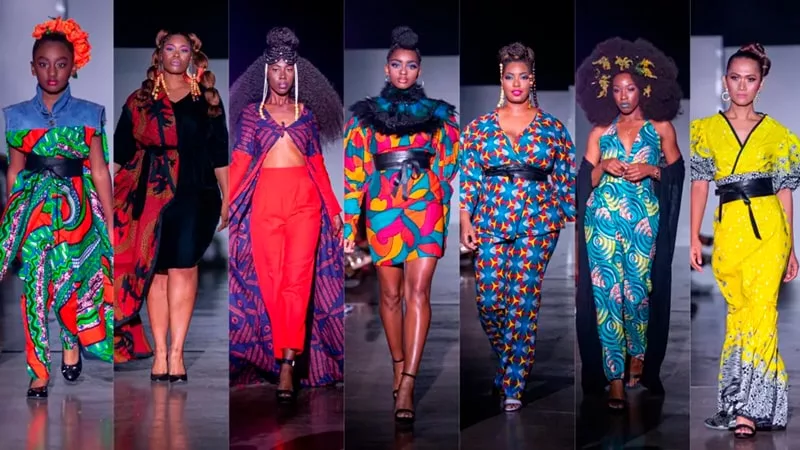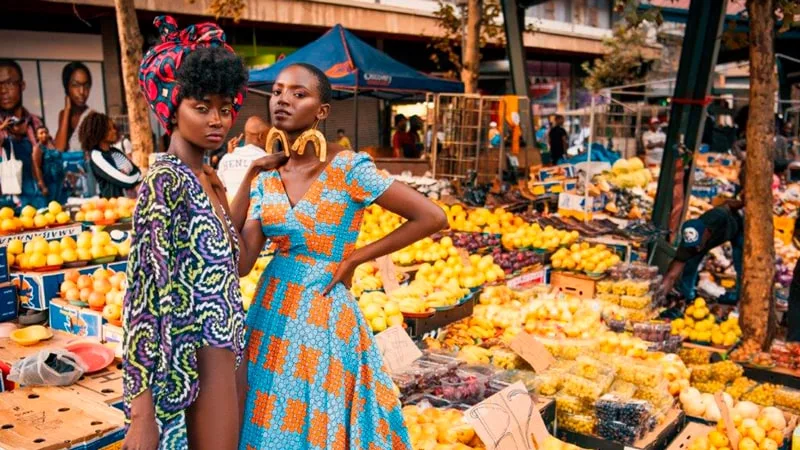Co-curator Ernestine White-Mifetu gives us an illuminating tour of “Africa Fashion” and the greater narrative it encapsulates.
At the Brooklyn Museum, an electrifying new exhibition establishes Africa as a true fashion capital, bursting with imagination, ingenuity, and its own aesthetic heritage. “African Fashion” showcases the designers and other creatives leading the continent’s charge into the 21st century.
Yet the exhibition, which runs through October 22, is much more than a wondrous fantasia of eye-popping looks on mannequins. By highlighting key pieces from designers, artists, and artisans from the mid-20th century onward, it illuminates a panoply of artistic visions to come out of Africa and its diaspora, laying the fascinating historical groundwork for today’s stylistic revolution.
The Brooklyn Museum is the perfect place for curators Ernestine White-Mifetu and Annissa Malvoisin to compile over 300 objects, including not only clothing and textiles but also jewelry, art, photography, and video, as well as vintage posters, magazine covers, and other ephemera.
It has been a century since the Brooklyn Museum became the first art institution to present African art to a North American audience.
The Brooklyn Public Library and the museum have collaborated to offer loanable copies of the historical books on display in the exhibition. According to the museum, it is the biggest installation of its kind ever made in a place in North America.
The Victoria and Albert Museum in London hosted the debut of “Africa Fashion” in 2022, but it has since profited significantly from its voyage to Brooklyn.
During the tour, co-curator Ernestine White-Mifetu said, “It was important that we insert the narratives of creatives here in North America.”
As the museum’s curator of African art, she and her colleagues modified the performance for a new audience, incorporating it into its new setting and complementing it with pieces from the museum’s own collection, one of the largest in the country.
A unique fusion of African and diasporic identity with American flair is the eventual product.
The exhibition has, for instance, pieces by Aurora James and Christopher John Rogers, two designers from Brooklyn who are garnering significant attention. James was featured on the cover of Vogue in 2020 with a painted portrait by Jordan Casteel due to her African-inspired designs and her 15 Percent Pledge program, which calls on fashion shops to allocate at least 15 percent of their shelf space to Black-owned businesses.
The year after he unveiled his collection in 2018, Rogers, 24, won the top honor at the CFDA/Vogue Fashion Fund.
The beginning of the play coincides with the end of colonial control in Africa.
In 1956, Morocco and Tunisia declared their independence from French rule. A year later, Ghana took control of itself from Britain. 1960, known as the Year of Africa, brought the independence of 17 additional African countries.
At the conclusion of the decade, that number had increased to 48.
These singular and significant independence movements sparked profound self-reinvention and awakenings that ushered in a cultural renaissance that reverberated across the arts. It’s significant that artists take inspiration from once-disadvantaged traditions to develop entirely original and avant-garde forms.
It was a turbulent yet energetic period that, in many respects, would not have been possible without the FESTAC festival series.
The first one happened in Dakar, Senegal, in 1966, and the final one happened in Lagos, Nigeria, in 1977.
The month-long festivals, as depicted in “Africa Fashion,” welcomed performers, writers, and musicians from all over the continent and beyond.
The largest cultural festival ever held on African land, it brought together up to 15,000 participants from practically every African nation (54 at the time) and the diaspora to inspire pan-African unity via the arts. According to White-Mifetu, “You see Langston Hughes and Duke Ellington going to FESTAC in 1966, and Stevie Wonder and Alvin Ailey in 1977.
Another famous participant in 1977 was Mama Africa, a South African musician and anti-apartheid campaigner. The Black and Brown figure and its full range of creativity were widely celebrated.
The first group of clothes is found in this cheerful context. According to White-Mifetu, “As the continent freed itself, artists used fabric as a visual language to engage with the new and hopeful political landscape.”
She motioned toward a collection of commemorative garments, which were worn to mark significant political occasions.
The final one features a photograph of Nelson Mandela shortly after he was elected president of the African National Congress of South Africa in 1991 alongside a more modern print created by Nigerian designer Lola Faturoti, who is based in New York and worked to honor Barack Obama’s 2008 inauguration as president.
The next section discusses the several textile traditions prevalent on the continent, including the silk kente, raffia-woven kuba, indigo-dyed àdìrẹ, strip-woven a-kè, and mud-painted bògòlanfini, to name a few.
Both the geometric patterns painted on canvas by South African artist Esther Mahlangu and the color blocks used in Atta Kwami’s 2011 painting Another Time are inspired by the kente culture of Ghana.
“And of course,” added White-Mifetu, “we couldn’t include a contemporary Yinka Shoniba sculpture in this dialogue around the influence of textiles and their histories.”
A group of dressmakers and tailors who found themselves converted into contemporary 20th-century fashion designers developed from this crackling frisson.
Chris Seydou (Mali), Kofi Ansah (Ghana), Nama Bennis (Morocco), Alphadi (Mauritania), and Shade Thomas-Fahm (Nigeria) are five of them that are highlighted in this article.
As designers started to seek outside of their borders, a lot of the clothing on exhibit is intriguing hybridization of African and Western fashions.
The work of Thomas-Fahm, the first designer to create a store in Nigeria after visiting Britain and discovering the designer boutique, exemplifies this.
She created wrapped skirts with built-in zippers and head wraps with snaps in an effort to modernize her clients’ wardrobes.
According to White-Mifetu, “She was designed for the contemporary young woman who didn’t have time for all that draping, wrapping, and assembling.
” “Women were much more mobile and active in the post-independence world.”
A section of the display devoted to photography, which has become incredibly important to African life ever since the development of the camera, is among its more moving elements.
The portraiture of Malian photographers Seydou Keta and Malick Sidibé in the 1960s and 1970s seems to be expanded upon in two stylized fashion images by Senegalese artist Omar Victor Diop, which then lead through a corridor to the work of Brooklyn-based Kwame Braithwaite, a Guggenheim Fellow and key figure in the “Black is beautiful” movement.
There are also Hassan Hajjaj’s daring, colorfully framed images.
The “Kesh Angels” series by the Moroccan artist, which was published in 2010, featured covered and veiled ladies sitting on motionless motorbikes in front of Marrakesh’s Theatre Royal while also donning heart-shaped sunglasses and striped socks.
The exhibition’s conclusion, a last display of modern outfits created in the avant-garde attitude, most effectively drives home the idea that contemporary African fashion is a massive synthesis of various communities and influences.
The focal point is a unique burqa designed by Artsi Ifrach for Maison ArtC and fashioned of translucent crinoline in the shape of a trench coat, an idea from Europe.
It was further covered by the Moroccan designer with embroidered hands, which White-Mifetu described as “an Islamic representation of belief.”
Thebe Magugu, a well-known South African fashion designer who won the LVMH Young Fashion Designer Prize in 2019 for his investigations into African spirituality and ancestral ties, also has his Alchemy collection featured in this area.
“I hope that the exhibition challenges viewers’ perceptions of African fashion,” White-Mifetu stated. “Africa has long and richly contributed to the global conversation, whether through visual art, music, or fashion.”
“Africa Fashion” is on display at the Brooklyn Museum, 200 Eastern Parkway, Brooklyn, NY 11238 until October 22, 2023.
Content Courtesy of Art Net News & NFH
Like this:
Like Loading...

